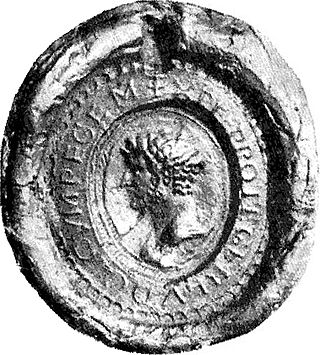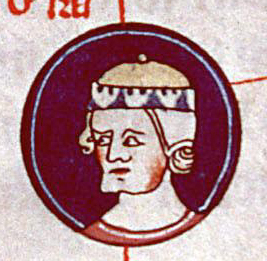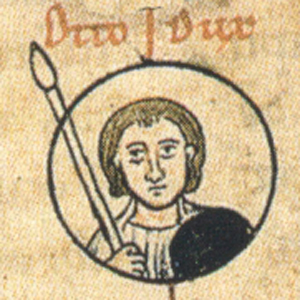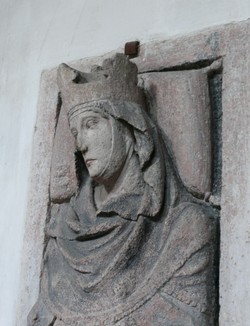
Louis the Pious, also called the Fair and the Debonaire, was King of the Franks and co-emperor with his father, Charlemagne, from 813. He was also King of Aquitaine from 781. As the only surviving son of Charlemagne and Hildegard, he became the sole ruler of the Franks after his father's death in 814, a position that he held until his death except from November 833 to March 834, when he was deposed.

Louis the German, also known as Louis II of Germany, was the first king of East Francia, and ruled from 843 to 876 AD. Grandson of emperor Charlemagne and the third son of Louis the Pious, emperor of Francia, and his first wife, Ermengarde of Hesbaye, he received the appellation Germanicus shortly after his death, when East Francia became known as the kingdom of Germany.

Charles the Bald, also known as Charles II, was a 9th-century king of West Francia (843–877), King of Italy (875–877) and emperor of the Carolingian Empire (875–877). After a series of civil wars during the reign of his father, Louis the Pious, Charles succeeded, by the Treaty of Verdun (843), in acquiring the western third of the empire. He was a grandson of Charlemagne and the youngest son of Louis the Pious by his second wife, Judith.

Hugh the Great was the duke of the Franks and count of Paris. He was the most powerful magnate in France.

Hedwige of Saxony, a member of the Ottonian dynasty, was Duchess consort of the Franks by her marriage to the Robertian duke Hugh the Great. Upon her husband's death in 956, she acted as a regent during the minority of their son Hugh Capet, the founder of the Elder House of Capet.

Frederick II, called the One-Eyed, was Duke of Swabia from 1105 until his death, the second from the Hohenstaufen dynasty. His younger brother Conrad was elected King of the Romans in 1138.
Ingerman , was a Frankish noble and Count of Hesbaye, son of a brother of Saint Chrodegang, the Bishop of Metz and therefore grandson of Sigramnus of Hesbaye.

Rudolph III, called the Idle or the Pious, was the king of Burgundy from 993 until his death. He was the last ruler of an independent Kingdom of Burgundy, and the last legitimate male member of the Burgundian line of the Elder House of Welf.

Otto, called the Illustrious by later authors, was a notable member of the Ottonian dynasty and Duke of Saxony from 880 until his death in 912. He played an important role in early medieval history of Germany during the 9th and 10th centuries, known for his military campaigns and diplomatic efforts.
The Elder House of Welf was a Frankish noble dynasty of European rulers documented since the 9th century. Closely related to the Carolingian dynasty, it consisted of a Burgundian and a Swabian group. It has not been definitively clarified, however, whether the two groups formed one dynasty or whether they shared the same name by coincidence only. While the Elder House became extinct in the male line with the death of Duke Welf of Carinthia in 1055, his sister Kunigunde married into the Italian House of Este and became the ancestor of the (Younger) House of Welf.

Judith of Bavaria was the Carolingian empress as the second wife of Louis the Pious. Marriage to Louis marked the beginning of her rise as an influential figure in the Carolingian court. She had two children with Louis, Gisela and Charles the Bald. The birth of her son led to a major dispute over the imperial succession, and tensions between her and Charles' half-brothers from Louis' first marriage. She eventually fell from grace when Charles' wife, Ermentrude of Orléans, rose to power. She was buried in 843 in Tours.

Henry V, the Elder of Brunswick, a member of the House of Welf, was Count Palatine of the Rhine from 1195 until 1212.
Burchard I, a member of the Hunfriding dynasty, was a Duke of Alamannia from 909 until his death. He also held the title of a margrave of Raetia Curiensis, as well as count in the Thurgau and Baar.
The Bosonids were a dynasty of Carolingian era dukes, counts, bishops and knights descended from Boso the Elder. Eventually they married into the Carolingian dynasty and produced kings and an emperor of the Frankish Empire.

Emma of Altdorf, also known as Hemma, a member of the Elder House of Welf, was Queen consort of East Francia by marriage to King Louis the German, from 843 until her death.
The Robertians are the proposed Frankish family which was ancestral to the Capetian dynasty, and thus to the royal families of France and of many other countries. The Capetians appear first in the records as powerful nobles serving under the Carolingian dynasty of Charlemagne in West Francia, which later became France. As their power increased, they came into conflict with the older royal family and attained the crown several times before the eventual start of the continuous rule of the descendants of Hugh Capet.
Conrad I the Elder was the count of several counties, most notably the Aargau and Auxerre, around Lake Constance, as well as Paris from 859 to 862/864. He was also the lay abbot of Saint-Germaine in Auxerre. Conrad's father was Welf. He was one of the early Welfs, a member of the Bavarian branch, and his sister Judith was the second wife of Louis the Pious.
The Conradines or Conradiner were a dynasty of Franconian counts and dukes in the 8th to 11th Century, named after Duke Conrad the Elder and his son King Conrad I of Germany.

Count Rudolph of Ponthieu was a son of Welf by Hedwig of Bavaria, and thus a brother of Judith of Bavaria, wife of Emperor Louis the Pious. Through Judith's influence, her brother Rudolph acquired and became Lay Abbot of the Abbeys of Saint Riquier and Jumieges.
Hedwig also Heilwig, was a Saxon noblewoman, abbess of Chelles, the wife of Count Welf, and mother-in-law of Emperor Louis the Pious through his marriage to Judith, her daughter.












